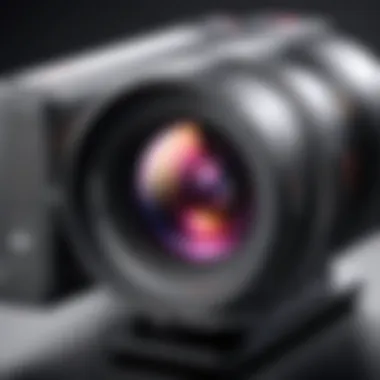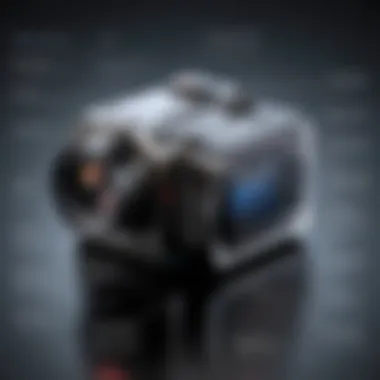In-Depth Insights on Motion Video Cameras


Intro
The interest in motion video cameras has surged in recent years, driven by technological advancements and a growing demand for high-quality visuals. From the cinematic landscape to the fields of security and surveillance, the applications of these cameras are both broad and deep. Understanding the specifications and performance of various models is vital for IT professionals and tech enthusiasts alike. This exploration seeks to clarify the intricate components that influence camera effectiveness and usability.
Performance Metrics
Performance metrics are critical in assessing motion video cameras. Metrics such as image quality, resolution, and frame rates are fundamental in determining their functionality across different environments.
Benchmarking Results
When evaluating motion video cameras, benchmarking results provide useful insights. Tests often highlight how various models perform under specific conditions. For instance, a camera with a higher frame rate may excel in fast-paced environments, offering smoother video playback. In contrast, low-light performance is essential for surveillance cameras.
Some significant considerations include:
- Resolution: Higher resolutions like 4K and 8K provide more detail.
- Bitrate: A higher bitrate generally indicates better quality, yet requires more storage.
- Compression: Understanding codecs such as H.264 or H.265 is vital. They reduce file size while maintaining quality.
Speed and Responsiveness
Speed and responsiveness are also crucial for user satisfaction. A camera's ability to capture images and process them in real-time can dramatically impact its effectiveness. For example, when documenting action sports, any lag can result in missed shots. Thus, manufacturers often prioritize fast autofocus and quick start-up times in their designs.
"The speed at which a camera system processes images correlates directly with its usability in dynamic situations."
Usability and User Experience
Usability directly affects how effectively a user can leverage a motion video camera. IT professionals often focus on the ease of integration with existing systems, setup time, and overall user experience.
Ease of Installation and Setup
Installation processes vary widely among models. Some cameras are designed for plug-and-play functionality, while others may require elaborate setup procedures.
Important factors include:
- Compatibility with various operating systems.
- Presence of comprehensive user guides or technical support.
- Availability of mobile or web applications for remote control.
Interface Design and Navigation
The interface design can greatly affect user navigation. A clean and intuitive interface allows for quicker adjustments and enhances the filming experience. Features like customizable menus and responsive touch screens can improve how users manage settings and view footage.
Preface to Motion Video Cameras
Motion video cameras play a pivotal role in today's digital landscape. With the growing demand for high-quality video content across various platforms, understanding the essentials of these devices becomes ever more significant. This section aims to unravel the importance of motion video cameras by examining their definitions and historical relevance.
Defining Motion Video Cameras
Motion video cameras are devices designed to capture, record, and process moving images. They range from simple consumer models to advanced professional systems. The defining characteristic lies in their ability to create sequences of images that create the illusion of motion.
The core functions of these cameras often include adjustable frame rates, resolution settings, and various recording formats. Users can find cameras that cater to different needs—from casual video capture on smartphones to specialized models used in film studios.
Historical Context
The evolution of motion video cameras has been remarkable. The journey began in the late 19th century with devices like the Kinetoscope, which allowed individuals to view short films. The introduction of the motion picture camera significantly advanced the film industry in the early 20th century.
As technology progressed, the 1960s and 1970s brought the videotape recorder into homes, revolutionizing media consumption. The late 1990s and early 2000s saw the emergence of digital video cameras, which transformed the filmmaking landscape.
Today, the development of high-definition and 4K resolution cameras, along with digital storage, has made high-quality video accessible to a broader audience. This historical context highlights how advancements have shaped not only technology but also the way content is produced and consumed globally.
Key Specifications of Motion Video Cameras


The realm of motion video cameras is defined not only by their innovative features but also by the specific specifications that dictate their performance. Understanding these key specifications is crucial for IT professionals and tech enthusiasts. It allows them to make informed decisions when selecting equipment that meets their needs, whether for personal projects or professional endeavors. This section will dissect the important aspects of motion video cameras, covering their resolution, sensor types, lens configurations, storage solutions, and battery life.
Resolution and Frame Rate
Resolution refers to the amount of detail an image holds. Higher resolution translates to clearer and more defined video quality. It is typically measured in pixels, with common standards including 1080p, 4K, and even 8K.
Frame rate is another critical element, measured in frames per second (fps). Standard frame rates are 30fps for everyday recordings, while 60fps and 120fps are popular among action camera users and filmmakers. Higher frame rates yield smoother motion, making them suitable for fast-paced action shots.
Both resolution and frame rate work in tandem; a high resolution without an adequate frame rate can result in choppy playback, diminishing the overall viewing experience. Thus, considering these specifications together ensures optimal video quality.
Sensor Types and Their Impact
Sensors are essentially the cameras' eyes, capturing light to create images. The two primary types of sensors are CCD (Charge-Coupled Device) and CMOS (Complementary Metal-Oxide-Semiconductor).
- CCD Sensors: Known for their superior image quality, CCD sensors work well in low-light situations. They typically produce less noise and have better color fidelity.
- CMOS Sensors: These sensors are becoming more popular due to their lower power consumption and faster processing speeds. Modern CMOS sensors can also produce high-quality images under various lighting conditions.
The choice of sensor greatly affects image quality and overall camera performance, making it an essential spec to consider.
Lens Configurations
Lens configuration plays a key role in determining the focal length, aperture, and field of view. The type of lens used can enhance a camera's versatility and performance in various shooting environments. Motion video cameras may have fixed lenses or interchangeable ones, allowing for more flexibility in capturing different scenes. Common lens types include:
- Wide-angle lenses: Capture broader perspectives, ideal for landscapes and indoor shots.
- Telephoto lenses: Offer zoom capabilities, useful for distant subjects.
- Macro lenses: Allow for extreme close-ups, beneficial in specific projects.
Choosing the right lens configuration can significantly impact the creative possibilities and overall effectiveness of a camera, making knowledge of lenses an asset for users.
Storage Solutions
Motion video cameras generate large amounts of data, so a suitable storage solution is crucial. The most common storage types include SD cards, CF cards, and built-in memory.
- SD Cards: Widely used, with varying storage capacities. They are generally affordable and easy to replace.
- CF Cards: Offer faster speeds and more durability, often utilized in professional settings.
- Built-in Memory: Some cameras come with internal memory, reducing the need for external storage but limiting upgrade flexibility.
A sound understanding of storage options helps users select cameras that align with their project requirements and budget.
Battery Life and Power Consumption
Battery life and power consumption are paramount to the usability of motion video cameras. Filming can be time-consuming, and users often find themselves in scenarios with limited access to power.
Understanding battery specifications, such as capacity measured in mAh (milliamp hours), can assist in selecting a camera that matches filming duration expectations. Many modern cameras also feature power-saving modes, extending operational time without sacrificing performance.
Moreover, some cameras support external power sources, providing further versatility during shoots.
Technological Innovations in Motion Video Cameras
The realm of motion video cameras is continuously evolving due to rapid advancements in technology. These innovations significantly shape how these cameras function, impacting their use in various applications. Understanding these technological shifts is essential for recognizing the full capabilities of modern motion video equipment. The enhancements not only improve image quality but also enrich user experience, making cameras more versatile and effective for both consumers and professionals.
Image Stabilization Techniques
Image stabilization has become a vital feature in motion video cameras. Traditionally, operators had to contend with shaky footage, particularly when capturing action scenes or moving subjects. Now, advancements like Optical Image Stabilization (OIS) and Electronic Image Stabilization (EIS) have emerged.
- OIS uses physical hardware, such as gyroscopic sensors, to adjust the lens or sensor position, reducing blur due to hand movement.
- EIS, on the other hand, relies on software to analyze the video and adjust frames dynamically, smoothing out unwanted jitters.
These techniques ensure that content appears steady and fluid, which enhances the viewing experience. For filmmakers and content creators, stabilized footage contributes to the overall professionalism of their work, allowing for creativity in various settings without the need for expensive external rigs.
Real-time Processing Capabilities
Real-time processing capabilities transform the way video is captured and edited. As cameras integrate advanced processors, they can handle data more efficiently. This capability allows for features like 4K recording, live streaming, and immediate playback without latency or lag.
- Modern cameras can apply filters, transitions, and effects during recording, an option that was unavailable in older systems.
- Real-time analysis also supports features like face detection, which helps ensure that subjects remain in focus even as they move.


These functionalities streamline the production process and reduce the post-production workload. For content creators, rapid processing means they can deliver high-quality videos faster, making processes more efficient.
Smart Features and Connectivity
As the demand for interconnected devices grows, motion video cameras are integrating smart features that largely enhance their functionality. Features such as Wi-Fi and Bluetooth connectivity allow for seamless interaction between the camera and other smart devices, such as smartphones and tablets.
- Users can transfer footage quickly for editing or sharing without needing physical connections.
- Some models include mobile apps that allow users to control camera settings remotely, making it easier to shoot from different angles or difficult positions.
Smart features also include voice control, enabling operators to give commands hands-free, which is particularly advantageous in dynamic shooting environments.
The blend of speed and convenience in connectivity opens new doors for collaboration and creativity in content production. As technology progresses, these innovations make motion video cameras more accessible and user-friendly, meeting the demands of both casual users and industry professionals.
"Technological advancements in motion video cameras give users greater control over their creative output while simplifying the production process."
In summary, the technological innovations in motion video cameras expand capabilities, making it essential for users to stay updated with the latest advancements.
Applications of Motion Video Cameras
The applications of motion video cameras represent a crucial aspect of the technological landscape. Understanding their varied uses helps demystify how these devices are reshaping industries and personal experiences. Motion video cameras have diversifying roles in both consumer and professional settings, providing innovative solutions in capturing and processing video content, monitoring environments, and facilitating real-time communications. As we delve into these applications, it is essential to recognize how they align with advancements in technology, and their potential implications for future developments.
Consumer Applications
In the realm of consumer use, motion video cameras have become ubiquitous, particularly in the age of social media. They are pivotal for capturing family moments, vacations, and events, often through popular devices like GoPro or DJI Osmo. The quality of consumer-grade cameras has surged, driven by advancements in sensor technology and computational photography.
The ease of use and portability make these cameras accessible to the average person, enabling anyone to produce high-quality video content. Social media platforms like Instagram or TikTok have further elevated the importance of motion video cameras by providing avenues for sharing and audience engagement. Another benefit is the connectivity options these devices often offer; many integrate seamlessly with smartphones and laptops, allowing for quick editing and sharing.
Professional Use in Film and Media
In professional domains, the use of motion video cameras takes on an intricate form. Filmmakers and content creators rely on high-grade cameras like the Blackmagic URSA Mini Pro or Canon EOS C300 Mark III to deliver compelling narratives. These cameras not only provide superior image quality but also offer features suitable for varied filming conditions.
Professional applications extend beyond traditional media production. Virtual production environments use advanced motion video technology to create dynamic sets that alter in real time.
Furthermore, in the context of broadcasting, live events have utilized motion video cameras to enhance viewer experiences. The need for high-resolution footage at varying frame rates has led to a significant rise in investment in professional-grade solutions, establishing a benchmark for quality across media platforms.
Surveillance and Security
The application of motion video cameras in surveillance and security speaks to their functional versatility. Systems such as those offered by Arlo or Ring have made substantial impacts in home security. These devices deliver real-time monitoring with features like motion detection and night vision. Customers value the peace of mind that comes with local and remote monitoring capabilities.
In commercial settings, businesses implement motion video cameras for loss prevention and safety compliance. The integration of artificial intelligence in these systems helps detect unusual activities, automatically sending alerts to security personnel. This proactive approach mitigates risks and ensures a safer environment for both customers and employees.
Industrial Applications
Industrial applications of motion video cameras showcase their significance in enhancing operational efficiency and safety protocols. In sectors like manufacturing and construction, these cameras monitor processes and ensure compliance with safety regulations.
For example, companies may deploy motion video cameras to observe workers in hazardous environments, helping identify potential safety breaches. Furthermore, these technologies are integral in quality control processes, where they assist in inspecting products for defects when combined with AI analytics.
The need for real-time data in industries is growing. Motion video cameras can aid in data collection, facilitating more informed decision-making. Organizations can leverage this visual data to optimize processes and improve overall productivity.
In summary, the applications of motion video cameras span across multiple domains, influencing how we capture moments, tell stories, ensure security, and enhance industrial processes. Their significance cannot be overstated as they continue to evolve with technology.
Comparative Analysis of Motion Video Cameras
In the fast-evolving sphere of motion video cameras, a comparative analysis serves as a crucial tool for understanding the diverse landscape. Examining the differences between various types of cameras helps consumers and professionals alike make informed decisions tailored to their specific needs. This section will investigate two primary frameworks: consumer versus professional cameras, and emerging brands versus established players.
Consumer vs. Professional Cameras
The divide between consumer and professional cameras is significant. Consumer cameras tend to prioritize ease of use, affordability, and portability. These models are designed for the average user who wants to capture moments without needing extensive technical knowledge. Features such as automatic settings and user-friendly interfaces are common. Examples include the GoPro Hero series and Canon VIXIA models, which appeal to casual users looking to document personal experiences.
On the other hand, professional cameras are built for serious videographers and cinematographers. These devices usually offer a broader range of features, including higher resolution, advanced manual controls, and superior image quality. Cameras like the Sony FX6 and Blackmagic Pocket Cinema Camera 6K are designed for film sets, providing the dynamic range and performance professionals require.


- Consumer Cameras:
- Professional Cameras:
- User-friendly interfaces
- Affordable prices
- Lightweight and portable
- High resolution and image quality
- Advanced manual controls
- Durable construction for extended use
The choice between consumer and professional cameras depends on the user’s needs. Casual users may find satisfaction with consumer-grade tools, while professionals will require the precision and capability inherent in higher-end models.
Emerging Brands vs. Established Players
Another intriguing aspect of the motion video camera market is the competition between emerging brands and established players. Established brands, such as Canon, Panasonic, and Nikon, have long histories of development and reliability. Their products are trusted, but they also carry higher price tags. Their advanced technologies and extensive ecosystems often justify the expense.
Emerging brands, such as DJI and Insta360, have introduced innovative and user-friendly products at competitive prices. These new names frequently leverage advancements in technology, like digital integration and cloud sharing, appealing to a younger generation of creators.
However, the comparison between these brands goes beyond price. Emerging brands often specialize in niche markets while established companies tend to have broader product ranges. For instance, while an emerging brand may focus on compact, action-oriented cameras, an established company may offer a wide array of solutions for every type of videography.
- Established Brands:
- Emerging Brands:
- Proven reliability
- Comprehensive customer support
- Extensive product ecosystems
- Price competitiveness
- Fast adaptation to new trends
- Innovative product features
A comparative analysis in this context assesses not only product specifications but also brand philosophy, market adaptability, and user satisfaction. Each customer will benefit from exploring these angles to identify the best fits for their distinct needs.
"Understanding the differences between consumer and professional cameras, as well as emerging brands and established players, can significantly influence one's purchasing choices in the motion video camera market."
This section encourages a thorough evaluation. By recognizing benefits, limitations, and specific applications, users can confidently navigate the motion video camera marketplace.
The Future of Motion Video Cameras
The evolution of motion video cameras stands at a pivotal point, where technological innovation meets creative potential. This section explores the significant trends shaping the future of these devices, while addressing the challenges that the industry must navigate. Understanding these elements is crucial for IT professionals and tech enthusiasts, as they reflect not only ongoing advancements but also the broader implications for content creation, surveillance, and industrial applications.
Trends and Predictions
The future holds promise for motion video cameras, influenced by rapid advancements in technology. Key trends to watch include:
- AI Integration: Artificial intelligence is set to revolutionize video processing. Cameras will increasingly employ AI to enhance features such as object recognition, scene detection, and automated editing. This will streamline workflows in both personal use and professional settings.
- Increased Resolution: With 8K becoming more accessible, future cameras will deliver stunning detail. This trend will cater to an audience desiring high-quality content for home viewing and professional projects.
- Enhanced Connectivity: The rise of IoT devices and wireless technology will foster seamless sharing and streaming capabilities. Expect to see cameras capable of instantly connecting with various platforms, facilitating easier content dissemination.
- Sustainability: The industry may shift towards environmentally responsible production methods. As awareness of sustainability grows, manufacturers might embrace materials and practices that minimize environmental impact.
- User-Centric Design: Future developments are likely to focus on user experience. Cameras will incorporate intuitive controls, making them more accessible for non-professionals while still catering to experts with advanced options.
"Technological enhancement, better resolution, and more connectivity will likely redefine how we create and share video content, catering to evolving demands across different sectors."
Challenges Facing the Industry
Despite exciting advancements, the motion video camera industry faces numerous challenges:
- Market Saturation: The influx of brands and models can overwhelm consumers. This saturation makes it difficult for new entries to gain visibility and differentiate their products in a crowded marketplace.
- Rapid Technological Change: While advancements are beneficial, the continuous pace of innovation can create uncertainty. Companies may struggle to keep up with technological trends while delivering quality products.
- Data Privacy Concerns: As cameras become more interconnected, concerns about data security and privacy also rise. Users worry about unauthorized access, especially in surveillance and smart cameras.
- Balancing Performance and Cost: High-performance cameras often come with a hefty price tag, which limits accessibility for many potential users. Manufacturers must find a balance between delivering cutting-edge features and keeping costs reasonable.
- Supply Chain Issues: Global supply chain disruptions can delay production and create shortages of components, hindering the launch of new models and affecting availability for consumers.
In summary, the future of motion video cameras is a complex landscape filled with potential and pitfalls. As trends emerge and challenges persist, it is crucial for stakeholders to remain informed and adaptable. This knowledge will enable them to leverage the capabilities of emerging technologies while addressing the ongoing issues that face the industry.
The End
Summarizing Key Points
In our examination of motion video cameras, several key points emerged:
- Technological Foundations: The evolution of motion video cameras is firmly rooted in significant technological advancements. The development of high-resolution sensors and sophisticated lens configurations has greatly enhanced image quality.
- Diverse Applications: Motion video cameras are used across a myriad of applications. The insights into consumer usage, professional film production, and industrial implementations emphasize their versatility.
- Specifications That Matter: Key specifications like resolution, frame rate, and battery life have been discussed, showcasing their importance in determining camera performance for particular needs.
- Future Directions: The analysis of trends and challenges provided foresight into how motion video cameras might evolve, informed by emerging technologies and consumer demands.
By identifying these core elements, readers can appreciate not only the functionality of motion video cameras but also their impact on various sectors.
Final Thoughts
In wrapping up, it is evident that motion video cameras are far from being merely tools for video recording; they are complex devices with the capacity to shape narratives, monitor environments, and capture experiences in unprecedented detail. For IT professionals and enthusiasts alike, grasping the intricacies of these cameras is essential for harnessing their full potential.
While challenges exist in the industry, such as rapid technological changes and market competition, the future looks promising. Continuous innovation is likely to yield more user-friendly, efficient, and capable devices.
As we look forward, keeping an eye on emerging trends and advancements will be necessary for those who wish to stay informed and adept in this dynamic technological field. Ultimately, embracing the potential of motion video cameras can unlock new opportunities across various domains, reinforcing their importance in both creative and industrial landscapes.



